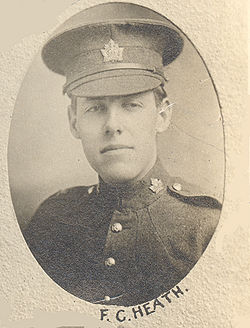Heath, Frank Clement
| Frank Clement Heath | |
|---|---|
| 2 July 1897 – 23 August 1972 | |
 | |
| Place of birth | Shelton, Stafford England |
| Allegiance | Canada |
| Service/branch | Canadian Army |
| Years of service | 1915-19 and 1921-1948 |
| Rank | WO (I) |
Personal Life
Frank Heath married Corrie E.A. Leaver on 27 August 1925 in Maxville Ontario. Together they had two daughters, Roberta and Verna.
Service
Frank joined 68th Battalion Canadian Expeditionary Force on 28 July 1915 listing his profession as a "moving picture operator". Although not a member of the Canadian Signal Corps or Canadian Engineers, he served in infantry Signals roles throughout the war. As with many Battalions, the 68th was broken up to provide manpower to other units. Frank served with the 32nd (Reserve) Battalion, the 11th Battalion, the 14th (Reserve) Battalion, 79th Battalion and the 27th Battalion. During his service with 27th Battalion, he received severe gun shot wounds from a machine gun to his legs on 3 May 1917 and he remained in hospital until 27 June. He was demobilized on 2 May 1919 after having spent time convalescing from September 1918 for 'debility'.
He again joined the military, this time with the Royal Canadian Corps of Signals, on April 19th, 1921 at age 23. He received training at Camp Borden Ontario prior to being transferred to work with the Northwest Territories and Yukon Radio System. He arrived in Dawson on Sept. 11, 1923 in charge of a RCCS detachment sent to set up the radio service. In 1928 he was posted to Ottawa but he returned to Dawson City on August 16, 1933 to resume charge of the station. In 1936 he was awarded the Long Service and Good Conduct Medal. He continued in his role at Dawson, serving more than 19 years there, until April 1947 when he then proceeded South for discharge and retirement.
He was discharged on 21 February 1948 having achieved the rank of Sergeant-Major (WO1).
Retirement
After retirement he settled in Vancouver with his family although he worked for a few years as purser on the Yukon and White Pass Railway paddle steamers running between Whitehorse and Dawson City.
Related Pages
Related Items
References
| ||||||||





